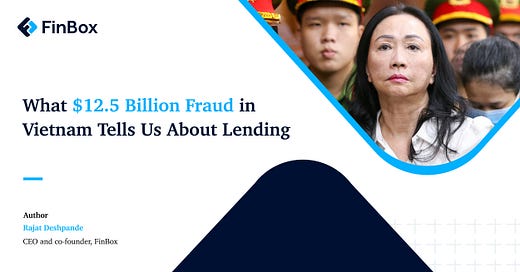What a $12.5 billion fraud in Vietnam tells us about lending
A wake-up call for banking technology and fraud prevention
Vietnam laid down a landmark verdict in 2024 on a decade long brewing banking fraud case in early 2024. In the historic judgement, the country handed down its first ever death penalty to a woman convict in a civil crime for defrauding $12.5 billion.
We are talking about the Saigon Commercial Bank fraud where a real estate tycoon, Truong My Lan orchestrated an audacious fraud that is now being viewed as a warning for the financial markets worldwide. This case is a stark reminder of the thread fragility that an unchecked financial services industry can brew within itself. And what’s the big picture to be discussed today? The urgency for stronger lending oversight and antitrust frameworks worldwide. Let me give you a little background first.
The Web of Fake Loan at SCB:
Lan used her influence to be elected to oversee the merger of three distressed banks and exploited her position to entrench herself in SCB’s loan issuance process quietly controlling the lending decisions of the bank. Using a huge network of shell companies and unauthorized bonds issuance, Lan created nearly 2,500 fraudulent loans amounting to $12.5 billion (which is equivalent to 3% of Vietnam’s GDP).
Lan’s arrest set off a chain reaction and depositors rushed to withdraw their money triggering a bank run that exposed the vulnerability with SCB’s operations. Despite of the $24 billion bailout attempt to stabilize the bank, the fallout of SCB brought in serious questions about Vietnam’s regulatory framework and the risks prevalent in the financial sector.
Why Does This Call for Global Banking Reform
The impact of SCB fraud case reverberates beyond the borders of Vietnam. It underscores the lacunas in the financial systems around the world. At its core, Lan’s loan fraud exploited the vulnerability of unmonitored lending! A risk that any financial system in any country can face. The case serves as a warming to financial institutions to emerging markets like India, without a rigorous loan approval process and protective regulatory frameworks, banks and economies will always remain vulnerable to exploitation by bad actors—be they individuals or syndicates.
Fraud is increasing in both ambition and scale, and there is an urgent need for smart technology intervention. The financial sector is in dire need to invest in credit intelligence engineering as they cannot solely rely on the traditional manual review and static rule-based systems. These systems often only detect fraud after the damage has occurred.
A case as big as SCB is hard to prevent easily but with robust technical banking surveillance and cross functional fraud detection tool, the small-time actors can surely be deterred. And sometimes it is the small bad actors who grow the audacious courage to exploit the system when gone uncaught for a long time.
To tackle the increasing complexity and scale of frauds, FinBox has built a host of solutions designed to detect and prevent financial fraud from working at the root cause level. With tools like BankConnect, an automated bank statement analyzer, FinBox scrutinizes transaction histories to catch inconsistency early on. With Account Aggregator Integration, financial institutions can get deeper finance analysis and get a comprehensive insight for accurate fraud detection and underwriting. DeviceConnect enhances security by monitoring device level data and identifying signs of suspicious activities.
To illustrate how this can make an impact in the BFSI space, let me take BankConnect as an example for loans and fraud detection since that holds a high relevance to the SCB fraud case.
BankConnect’s ML algorithm assesses transaction histories, scrutinizes payments behaviors, overdrafts, and a customer’s balance patterns. This enables us to detect anomalies such as fabricated cash inflow typically found in loan frauds, where often ghost, accounts are used to secure advances with inflated or false cashflow information.
By flagging these inconsistencies, BankConnect directly addresses the risks tied to new account frauds and instances of loan kiting.
With AA added to this, financial institutions can also flag instances of cross-account transactions, circular payment patterns, unusual spending spikes that are often linked to money laundering.
By integrating these advanced intelligent engines, FinBox aims to aid financial institutions in proactively guarding frauds and preemptively identify and intercept a broad spectrum of frauds prevalent in the space.
SCB Fraud Marks as the Beginning of a Global Dialogue on Banking Integrity
Nearly after 6 months of the verdict, Vietnam is standing strong to combat financial fraud and bring in reforms, for SCB was a defining moment for the country and a cautionary tale for world. Let me know your thoughts on the SCB fraud case and how do you think credit intelligence infrastructure can help prevent a case like this in the future?




